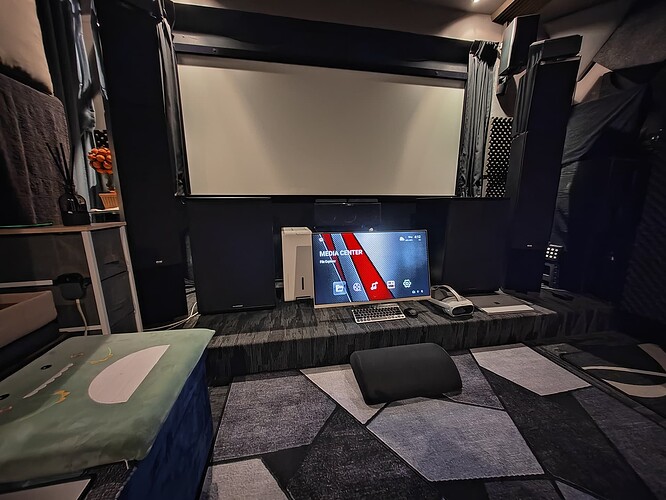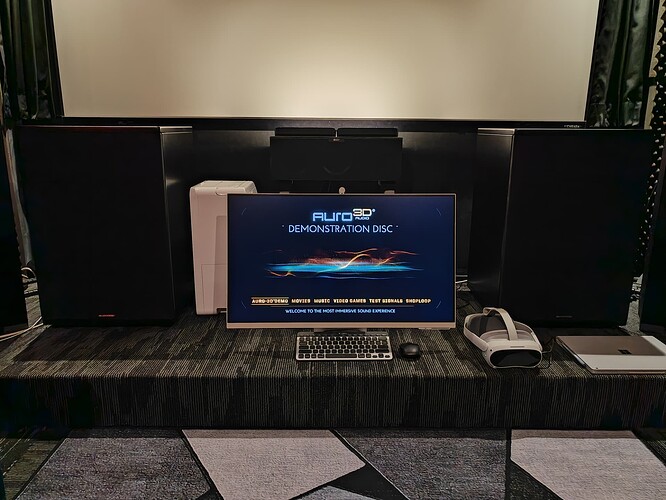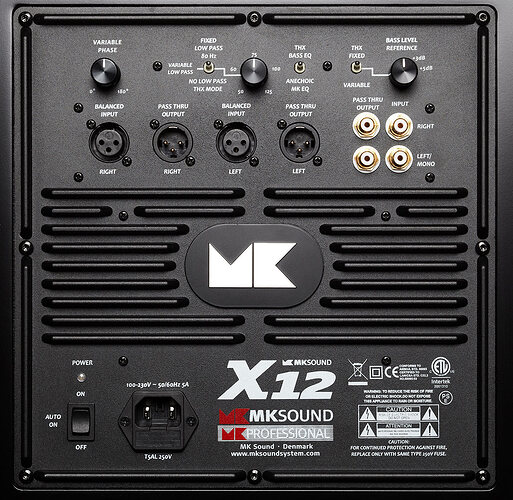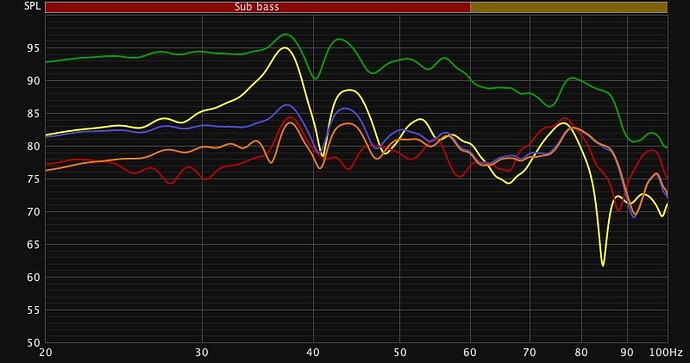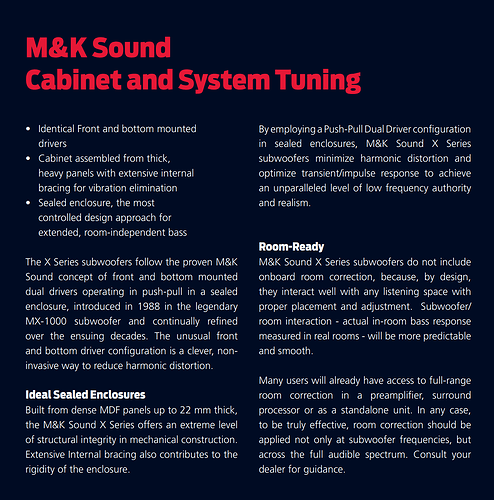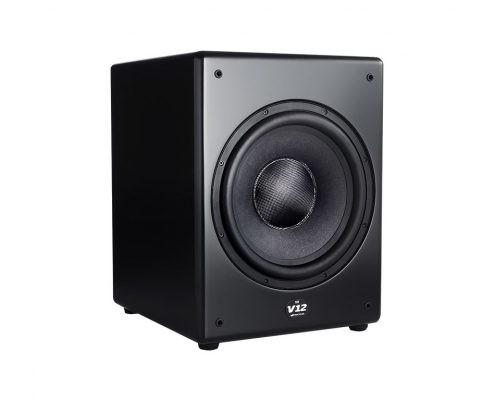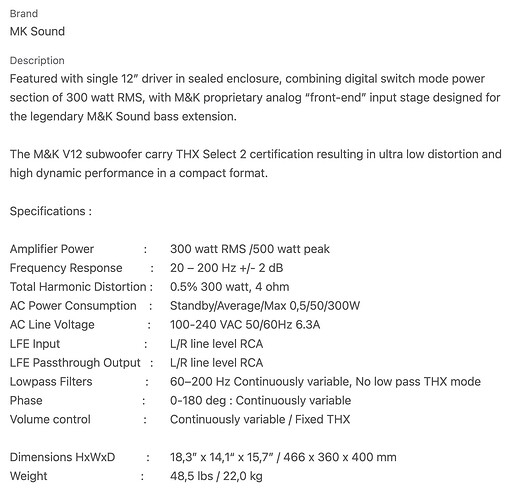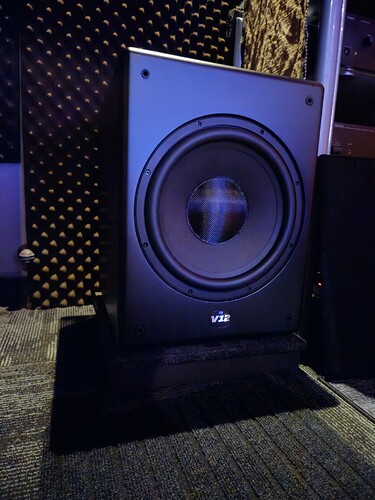Let’s get the first thing out of the way. The M&K Sound X12 subwoofer has just clinched the top spot in my “must-have” home theater AV gear. It exceeded my expectations and more…
OOTB: No user manual
Let’s address the “not-so-good” thing first. It doesn’t come with a user manual. C’mon M&K Sound?! What is this?! This is unacceptable! I literally have to download the user manual (pdf format) from their official website to get down to the nitty-gritty of the controls. Fortunately, I am pretty impressed by the info in the user manual. The controls and their corresponding functions are succinctly explained. This is especially useful for first-time M&K users like me.
Moving the beast
A second 12" driver hidden beneath the enclosure.It is heavy, weighing about 36kg. I am impressed by the double-carton packaging to ensures the original retail carton will be well-preserved through transportation. A nice touch.
You can imagine how I need to devise a tactic to “move” the subwoofer alone. Yes, you can move it by yourself. You just need to employ the “right” technique to “move” the “beast”. Instead of sheer brute strength by lifting up and risking hurting your back. You just need to make it “walk”. The technique is to move slowly and pivot one “step” at a time (like a baby starting to walk on in an ungainly gait) until you reached the point of your “destination” or X-spot. It is not easy but doable.
Picking the spot
As you can see, I bought 2 at one goal since it helps me with some bargaining power over the agent, Global Audio Marketing. Frankly, the sheer size of the X12 is going to pose a problem with placement in your listening area, especially for HDB dwellers like me. Worse, my home theater lair sports a typical 4.5m x 4.5m real estate with limited choice in placement. I have tried to place them diagonally across each other but found the same issue with the room mode where there is a drastic spike of nearly 8dB in output level between the 40hz - 50hz region. Of course, it is not really an issue here since ARC can easily fix this by cutting down the peak by as much as 6dB. I thought to myself, since the “same spot” exhibits the same room mode issue, let’s do a “union” of the 2 subwoofers. While going against best practices, I have decided to use a Y-splitter to send out the same LFE signal to the pair of X12 located at the front stage, sandwiched between the mains and center (look at how amusingly small my KEF R200 center speaker appears in between the 2 giants).
Based on my experience with my dual JL Audio E112 placement at the same location (front stage). I tuned the phase knob for my left X12 to 0 degrees and the right X12 to the opposite end of the phase spectrum (at 180 degrees). This produces the smoothest bass response “in my room”. This takes away a lot of guesswork since I have been using the same room for a decade now.
Settings
Before attempting any form of Room EQ calibration, one will need to choose the correct settings at the rear of the subwoofer. Let’s dive in to have a better look and understanding of what those settings mean.
The layout is intuitive and there is a good reason for each function to be located in such a layout. The only “missing” feature is the polarity switch (normal vs inverted) which can be found on the JL Audio E series subwoofers.
Starting from left to right. The left panel featured the variable phase knob. As mentioned, I have set the phase to ‘0 degrees’ for the left X12 and ‘180 degrees’ for the right X12. Moving on to the pass filter or crossover for some other brands out there. If one is using Pre-Amp and AVR to do the bass management, the “No Low Pass THX mode” is the option to select. Since this is a THX-certified subwoofer, the usual suspects of THX Fixed 80Hz crossover is a feature that one can select. ONLY, I repeat ONLY choose this if you have full THX-certified speakers and a THX-certified Pre-Amp or AVR to take advantage. For the rest, you only need to set the flip switch to “No Low Pass THX mode” once and forget. For variable low pass (crossover), use it for 2 channel music setup for you to blend in the mains and the subwoofers.
Now comes to intriguing part, the THX Bass EQ vs the Anechoic MK EQ. In simplest terms, it meant the output levels that you desired to produce. This set feature will work hand in hand with the desired gain knob you choose. For a typical THX listening environment, reaching an output level of at least 80dB to a max of 85dB is desirable but your speakers may not be able to keep up with those numbers. This is WHY I mentioned that THX is rather stringent with its requirements. If your speakers are not THX certified, then you can ignore all these THX settings. Back to this EQ setting, THX Bass EQ targets an 80hz crossover and that is generally meant for towers and bookshelf capable of producing a reasonable amount of bass at a crossover of 60hz - 80hz. Anything higher like satellite speakers should refrain from selecting THX Bass EQ. The opposite holds true for Anechoic MK EQ for speakers used in smaller rooms with limited real estate.
Lastly, the gain knob or what M&K Sound referred to as “Bass Level Reference”. There are basically 2 options. If you decide to go all in for the THX route, then flip the switch to “THX fixed”. This will help to ensure the output level will always hit a hard of 82dB or higher. For everyone else, you will want to use the “variable” setting to adjust the gain in accordance with the type of Room EQ being used. For instance, in my case, I am using Anthem Room Correction or ARC to calibrate my entire home theatre system. Using the Quick Measure feature in the ARC Genesis EQ software allows me to set the correct output level for ARC to work “properly” (Yes, ARC can be rather picky when it comes to bass level output. I will share more in the Anthem thread or at my workshop).
For those who want to pair the subwoofers into “one giant” subwoofer, you can either use the Y-splitter running a separate coaxial cable connecting between the Pre-Amp/AVR and the Input connection of the X12s or you can connect one coaxial cable using the “Pass Through” from one of the Output connection and connect it to one of the Inputs (RCA) of the other X12. The choice is yours, just make sure to play around with the phase knob at the back of the panel to get a smooth response between the mains and the subwoofers. For ARC users, this is relatively easy to achieve as there is a little segment called Quick Measure to find the right blend.
Measurements
ARC worked superbly well with the X12s and before long, I have made all the necessary adjustments and allowed ARC to take over the spatial domain/time adjustments to arrive at the correct phase setting. For those interested to know how to fine-tune your ARC using advanced settings, join the workshop and I will show you the tips and tricks to dial in your ARC post-calibration settings within an hour. It is not too difficult once you learn the trick.
Simply measuring the raw freq response of the dual X12, I am super impressed by how linear the response can get (with ARC turned on). The “blue line” is with THX Bass EQ engaged.
Selecting Anehcoic MK EQ (smaller room) and with my mains crossover at 80Hz, the freq response is almost flat across the board from 20hz up to the crossover point. I am not able to get such a linear response from my dual E112s at that “same spot”.
For those interested to know what happens when the THX Bass EQ mode is used in conjunction with with gain level set at THX fixed. Just take a look at the “green line” depicting the “+10dB jump” in the output level which literally caused a “distortion warning” to appear on the REW during the reading! Luckily the X12 has a built-in DSP mode or rather a limiter preventing the drivers to overblow. So no matter how loud and deep a bass note hit, you will know the subwoofer will survive the ordeal.
The “orange line” depicts the much more subdued output of around 75dB for most home theatre settings. This is with the Anechoic MK EQ engaged and the variable gain knob engaged.
The “red line” is the combined response curve with JL Audio E110 acting as my second subwoofer. It is located at the rear of the room on my right. As you can see, it holds well at 75dB and slightly better response compared to when only one pair of X12s is used.
Lastly, for good measures, the “yellow line” is thrown in to depict ARC off. You can see a nasty peak in the 37hz region a rather narrow sharp dip at 84hz. Overall, ARC did a fantastic job in time aligning the mains and the subwoofers imo. ARC continues to impress me after all these times.
Local Agent for M&K Sound
For those interested, you can contact the agent, Global Audio Marketing P/L for pricing.
I have to thank the boss for delivering the two X12s to my place (Yishun) from their office in Ubi.
Part 2 on my impression of movies, 2 channel listening, and Dolby Atmos movie/music streaming to come soon…
